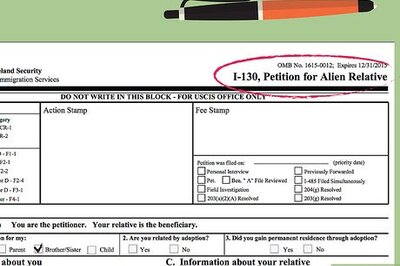
views
Common Roles in Dysfunctional Families
The Golden Child In a dysfunctional family, one of the siblings may become the golden child, also called “The Hero” or “The Saint.” This child receives special treatment and excessive praise from their parents, whether or not they've actually earned it. In the parents’ eyes, the golden child is an idealized hero who can do no wrong. You’ll often hear the parent of a golden child asking their other children, “Why can’t you be more like your sibling?” The parents of a golden child may focus on praising them to distract from the family’s real problems. They may also highlight the golden child’s achievements to convince themselves that there’s no issue with the family. This family dynamic often develops when one parent is a narcissist. The narcissistic parent projects their positive self-image onto the golden child, making them the parent’s “favorite.” Effects: In adulthood, former golden children often struggle with self-esteem issues, people pleasing, perfectionism, anxiety, or depression.
The Scapegoat, Black Sheep, or Problem Child The scapegoat is the family member who gets blamed for all of the family’s problems, whether or not they’re actually at fault. This role is usually (but not always) held by one of the children in the family. No matter what the scapegoat does to please their parents, they’re constantly put down and criticized. They’re essentially the opposite of the golden child—where the golden child can do no wrong, the scapegoat can only do wrong. The parents in a dysfunctional family may focus on criticizing the scapegoat to shift the blame away from themselves and distract from the family’s real issues. Scapegoating often occurs in families with a narcissistic parent. The parent projects their positive qualities onto one child (the golden child) and their negative qualities onto their other child (the scapegoat). Effects: In adulthood, former scapegoats may struggle with depression or self-harm, PTSD, people pleasing tendencies, or codependent behaviors.
The Lost Child The lost child is the sibling who tries to blend into the background to survive all of the family’s conflicts. In an attempt to make it through all the tension and dysfunction unnoticed, the lost child withdraws or isolates themselves. As a result, the family members brand them as a “loner,” or forget about them altogether. To escape their dysfunctional family home, lost children may spend most of their time at friend’s houses, or fill up all of their time with extracurriculars. Effects: Due to the neglect they experience in childhood, lost children may struggle with self-esteem issues, addiction, destructive behaviors, or unhealthy relationship dynamics in adulthood.
The Peacemaker or Mediator The peacemaker takes on the job of keeping everyone happy and maintaining harmony in the home. They may sacrifice their own emotional wellbeing to care for family members, and they’re often forced to act as a mediator between family members who are arguing with each other. Peacemakers are often children who try to smooth out tensions between their two parents, or siblings who try to resolve conflicts between their parents and a rebellious sibling. Peacemakers may also be a parent who tries to pacify their easily-angered spouse. Effects: Those who served as peacemakers in their family may become extremely uncomfortable with anger. As a result, they may become very conflict-avoidant and struggle to express themselves when they're upset.
The Clown or Mascot Like the peacemaker, the clown tries to defuse tensions in their dysfunctional family unit. Unlike the peacemaker, however, the clown primarily uses humor and playfulness to distract from the family’s problems and keep up a light atmosphere. Effects: Those who were the clown or mascot in their family may use humor to avoid discussing serious issues in their adult relationships.
The Parentified Child In dysfunctional family dynamics, a child is sometimes forced to take on roles that are typically the parent’s responsibility. For example, a parent may look to the child for emotional support and reassurance, rather than the other way around. Or, a parent may rely on the child to take care of important household matters that aren’t age appropriate, like paying bills or making sure everyone is fed. Effects: Former parentified children often become hyper-aware of other people’s needs, and they may focus on taking care of others at the expense of their own mental and emotional wellbeing.
The Enabler or Caretaker To maintain the appearance of happiness or normalcy in the family, the enabler may excuse or hide the negative behaviors of other family members. For example, if one family member is an alcoholic, the enabler may dismiss their behavior or help them hide the evidence of their addiction, rather than getting the family member the help they need. The enabler’s efforts may make everything look better, but it actually prevents the family from healing and tackling important issues. Effects: Enablers may be so focused on keeping up appearances that they neglect their emotional needs. They may also make excuses for bad behavior in their other relationships, leading to unhealthy or toxic situations.
The Identified Patient The identified patient is a family member who has a mental health disorder, and because of this, the other family members see them as the “reason” for all the family’s problems. For example, a dysfunctional family may say that they’re seeking out family therapy because one of the children has depression or substance abuse issues. The other family members mistakenly assume that all their difficulties are a result of the identified patient’s mental health, when in actuality, the whole family exhibits dysfunctional behavior. Effects: Those who were the identified patient in their families may deal with self-esteem issues and self-blame, on top of the mental health struggles they were already dealing with.
How to Cope and Heal from Dysfunctional Family Roles
Set healthy boundaries. Let your family know what kind of behaviors are acceptable and unacceptable in your relationship. Say, for example, that you were a parentified child, and your parent still expects you to emotionally support them in adulthood. Try setting a boundary around the amount of time you’re available to provide support. You could say, “Mom, I’m available to meet for lunch or talk on the phone once per week, but I won’t be able to connect outside of those times, unless it’s an emergency.” Or, say you were the scapegoat in your family unit. Try setting boundaries with your family members about the type of communication that you’ll be willing to engage in. For example, you could say, “I’m willing to have a mature conversation when you’re upset, but if you start yelling or unfairly insulting me, I’m going to step outside or hang up the phone.”
Practice self-care. Being a member of a dysfunctional family can take a serious toll on your emotional and mental wellbeing. Because of this, it’s especially important to focus on self-care and prioritize your own needs. Set aside time in your schedule to do the things you love, like connecting with friends or participating in your hobbies. If you’re feeling especially stressed out, try pampering yourself with a relaxing bubble bath, or watching your favorite comfort movie. Here are a few more ideas for self-care: Get a good night’s sleep Spend time outside in nature Read a good book Journal about your thoughts and feelings Take a yoga class Meditate or pray Practice mindfulness
Work on communication together. Dysfunctional families often have poor communication skills, but healthy communication is key to healing your family dynamic. When spending time together as a family, try to focus on actively listening to each other and sharing your perspectives in a respectful, loving way. This means paying attention while other family members are talking and doing your best not to react with anger when someone voices the way they're feeling. It may also help to put away phones and electronic devices during family time, so you can focus on communicating and connecting.
Talk to a professional. Many dysfunctional family dynamics are difficult to navigate without the help of a professional. If you’re in this situation, consider seeking out treatment with a licensed therapist or counselor. If your family is willing, you could all visit a family therapist together, but individual therapy can also be incredibly helpful. Remember, you don’t have to go it alone, and healing is possible! Ask a trusted friend for a referral if they work with a therapist, or check out online directories to choose the right therapist for you.




















Comments
0 comment